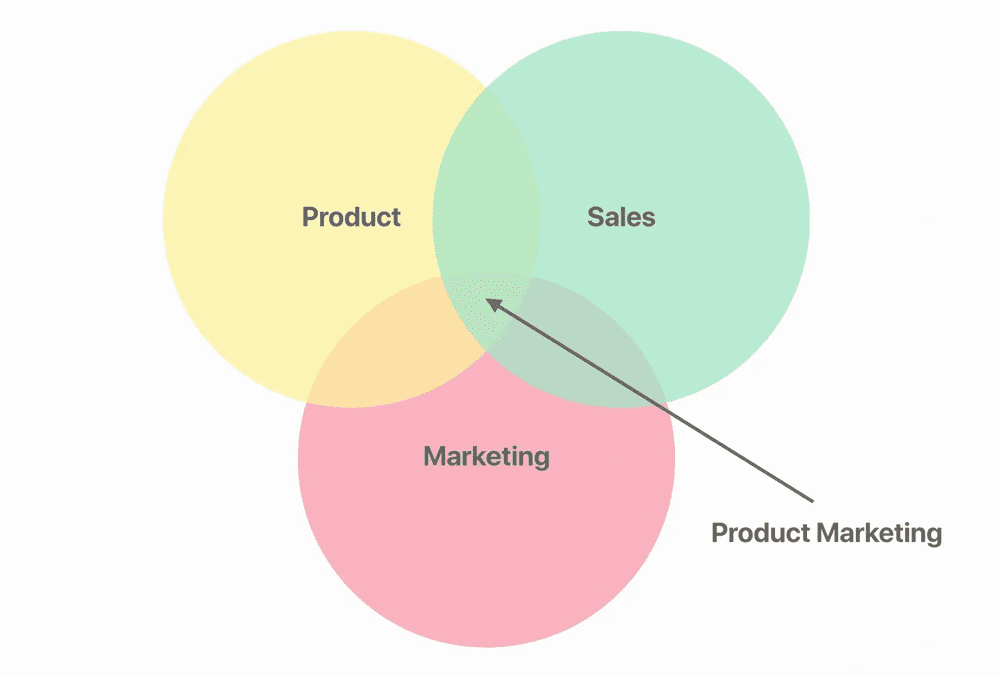If you’re a Product Marketing Director, Manager or VP, this article is for you.
Product marketers are faced with ever growing pressure from their leaders to expand the reach of their products or services, fast. However, fast may not always be a good recipe.
The pandemic has definitely made business more challenging for everyone, especially marketers. What used to work prior to covid-19 is now either irrelevant or hardly efficient in this digitally-oriented era.
It’s in times like these that we must take a step back, reflect on what’s working and what’s not and pivot accordingly.
In this article, I will share a 4 step framework to help guide your reflection. As a preliminary word of caution, what I will outline is not easy – it’s meant to challenge your organization and might take weeks if not months to complete.
However, implemented correctly and through an objective-lens, the value to your organization will be tenfold.
Are you ready?
What is Product Marketing, Exactly?
Before we dive into our transformational 4-step framework for product marketing teams to implement, it’s useful to review the basics and gain a clear understanding about what is product marketing.
Hubspot, a leader in the development of marketing software products for inbound marketing, sales and customer service describes it as:
Product marketing is the process of bringing a product to market…this includes product positioning and messaging, launching the product and ensuring that sales and customer service understand it.
Pretty simple, no?
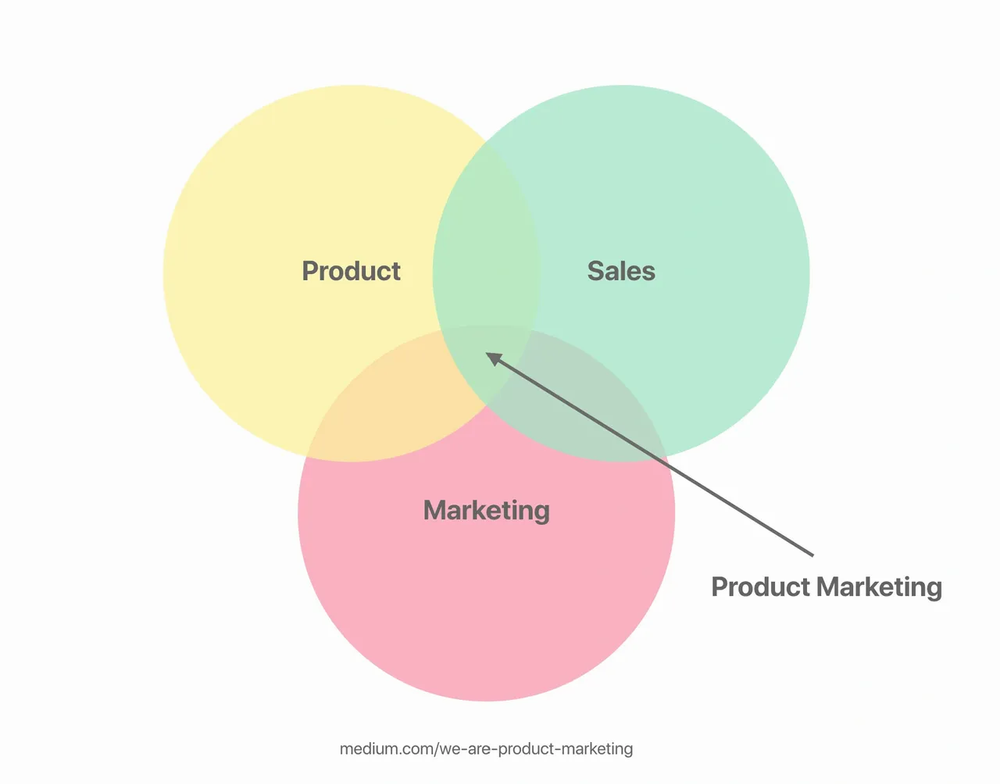
Unfortunately, given the rapid nature of the economy today, in large part due to the coronavirus pandemic, the definition of product marketing at most B2B organizations is rather ambiguous.
Product marketers at most startup companies and even established organizations are typically considered to be an aide to product managers or commonly known as product owners in SaaS where their roles are confined to developing content like case studies, graphics, whitepapers etc.
However, there is more to it.
As we’ve outlined earlier, product marketers are often involved in positioning a company’s products or services in the marketplace which is backed by market information. Furthermore, top producing product marketers back their positioning with a thorough competitive analysis.
So, why is product marketing so challenging in 2021?
Let’s find out.
What Are the Top Challenges in B2B Product Marketing?
Now that we’ve reviewed briefly what is product marketing and the role of product marketers, it’s time to dig a little deeper into challenges faced by most B2B organizations, small or large.
- B2B Product Marketing Challenge: Mapping Out the Buyer Journey
One of the major roles product marketing teams play is in arming the sales teams with value-added content to move the prospects through their buyer journey which on average takes about 3 months.
The top steps in a buyer journey include:
- Awareness (Product Marketing)
- Engagement (Product Marketing)
- Evaluation (Sales)
- Purchase (Sales)
- Post-Purchase Phase (Customer Support)
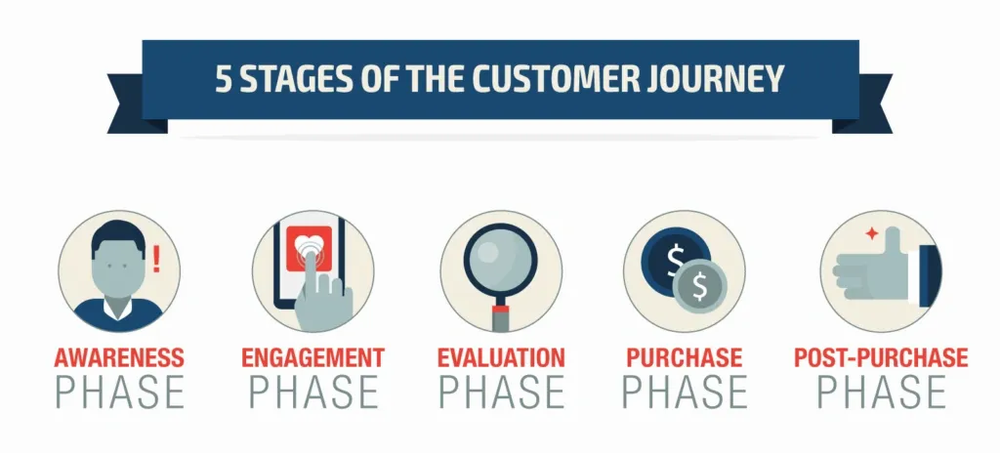
Awareness & Engagement
Arguably the most important roles PM teams play across the buyer journey lies in the Awareness and Engagement phases. In this very early stage of the buying cycle, prospects are either browsing the internet for brainstorming purposes or they think they might be having a problem they don’t know yet how to solve. However, they do not know they have a real problem yet.
Product marketing teams play a crucial role in this part of the journey because they have to convince cold leads they probably have a problem. The challenge lies in that they have to think about translating the solution to those problems across different types of content and for different stakeholders.
Being a product marketer doesn’t seem so easy, does it?
It’s product marketing’s role through positioning and brand messaging to convey to target customers that their company is the only company that can solve it.
How do we do this?
Well, we have to go back to our buyer personas to understand 3 main things:
Who do we need to convince at target organizations that this is the right solution for them?
Look at your existing customer contracts and look for patterns. Who has signed off on the deal across small, medium and large organizations? Odds are, it’s likely more than 1 person in a complex B2B deal.
Why does it matter?
Depending on if it was a CEO/CFO who made the purchasing decision at a small-medium company or a division leader at a large organization, your content production to nurture the prospects across the buyer journey will change.
How do they evaluate a purchasing decision (criteria)?
Different stakeholders have different needs and priorities. Therefore, what their needs and priorities are affect their decision to go with your solution or not. Furthermore, it’s important to note that in addition to mapping out the buyer journey, product marketing teams need to understand the different types of roles stakeholders play at a company.
As a rule of thumb, I like Jeb Blount’s BASIC formula:
- Buyers: Make the purchasing decision (budget authority).
- Amplifiers: Will push for your technology/solution or services because they see the value.
- Seekers: As the name suggests, they procure or inquire about your services early on. They usually have little to no decision-making authority as discussions move forward.
- Influencers: These stakeholders are heavily relied upon by the person in-charge of the budget. In a SaaS sales cycle for example, the internal tech teams at organizations like CTOs or CIOs will often make or break with your solution depending on if it fits with their tech stack.
- Coachers: We love a good coach! Coachers are the stakeholders that guide you through the miserable path of a complex sale. They want to help you succeed.
The challenge for Product Marketing teams is to understand who are the typical stakeholders involved in their deals across small, medium and large organizations.
From there, there is an additional challenge in needing to reverse engineer content in the right form and with the messaging that speaks to these stakeholders.
For example, I am the President at Toledo. At our company, any purchasing decision must be quantifiably justifiable and with a clear potential ROI. Typically, leaders with budget authority at any organization make investment decisions along the following lines:
Introducing the ITR Framework
- Investment: what is the going to cost us in real dollars and opportunity cost?
- Time: what’s my payback period on this investment (when do I make my money back)?
- Return: how much money am I saving or adding in incremental revenue when the solution is fully implemented?
Assuming I am a PM of a SaaS company, and sales are in the closing stages of negotiations, I would probably want to push a tailored piece of content to the CEO of X in the form of an ROI calculator (marketing content).
See how personalized that was?
How does each stakeholder consume information?
Another challenge in the Awareness and Engagement phases for Product Marketers lies in understanding how different stakeholders consume information. This is where their content development role plays a serious part in the buyer journey.

Once more, different types of stakeholders (different job functions) result in different methods of communication.
Again, it’s PMs’ and Sales’ duty to go back to customer profiles to understand what the best channels and formats for communicating valuable information to target stakeholders are.
Let’s look at this from an anecdotal example.
In my experience marketing and selling complex SaaS and Technology, I noticed an intriguing pattern from one client mandate to the next and one deal to another.
Throughout all engagements, I was talking to the VP of Technology or Director of IT at client organizations (shocker!).
But through managing those client relationships and nurturing those prospects through the funnel, I noticed how they consumed information.
I found out early that technical stakeholders like CTOs frequently consume information in educational formats.
What does this mean?
Well, it means I need to develop content that would get them to engage with my offering and offer detailed insights into tech specs (education!).
The best content for marketing SaaS/Tech or AI:
- Webinars
- Complex Infographics
- Complex Whitepapers
Of course, I tailored the last two pieces of content to the individuals I was speaking with – that’s what needs to be done to close large 6 figure deals these days!
The point is, product marketing managers have to adapt their content to the deal type and stakeholders in front of them. After all, you can’t build awareness or engage prospects if there is nothing to be aware about, can you?
Create awareness with targeted content, then engage those leads and prospects with even more defined content that guides them through their buyer journey!
2. B2B Product Marketing Challenge: Alignment with Sales
The second challenge product marketers face right now is aligning with Sales. As we mentioned in challenge #1, product marketers have a critical part to play in a buyer journey as it relates to Awareness and Engagement phases.
Finish what you started…as the saying goes!
Well, product marketers need to do exactly that; the job is only done when a prospect turns into a client.
4 Key Sales Metrics for Product Marketing to Align with Sales
I am going to share 4 marketing metrics I implement at client organizations. Two of them, you most definitely have seen. The other two, it’s unlikely you’ve seen them frequently. I’ll let you guess which ones are which.
- First Meeting: Lead Ratio (%)
- AVG Sales Cycle Time (Days)
- AVG Time Between Next Steps (Days)
- Win-Rates (%)
First Meeting: Lead Ratio (%)
This is one you must be tracking currently and is commonly referred to as Sales Qualified Lead ratio. However, I don’t quite like that terminology because it really does not give us any indication of how our demand generation strategy is performing.
The idea with this metric is too validate 3 things:
- Are we targeting the right stakeholders?
- Is our messaging resonating with our audience?
- Do we have enough pre-qualified leads in the pipe?
If one or more answers to those questions is a “no”, then you must go back to your customer profiles and start looking to fine tune your strategy.
Moreover, looking at this metric with this terminology encourages alignment with Sales; it encourages collaboration to mutually agreed objectives of closing XYZ types of clients.
AVG Sales Cycle Time (Days)
It’s unlikely you’ve seen this one frequently at sales or marketing organizations. Why, I am not sure.
I’ve used a similar valuation metric in the past when working in the acquisition space to identify opportunities for improvement at target companies.
The Cash Conversion Cycle (CCC), is a financial metric used by investment banks, private equity groups and institutional investors to discern how liquid a company is. In other words, how many days does it a company to convert investments in inventory and other resources into cash flow.
The same can be applied to sales cycle times and it should given that we’ve already established that B2B sales cycle times are often long.
Marketing and sales must take an honest look at their previous deals and track how long it took on average to close a deal. The larger this number, the more opportunity for improvement.
How do we reduce it you ask?
Keep on reading.
AVG Time Between Next Steps (Days)
To identify a problem, you must take your current situation and break it down into the smallest parts in order to find a solution.
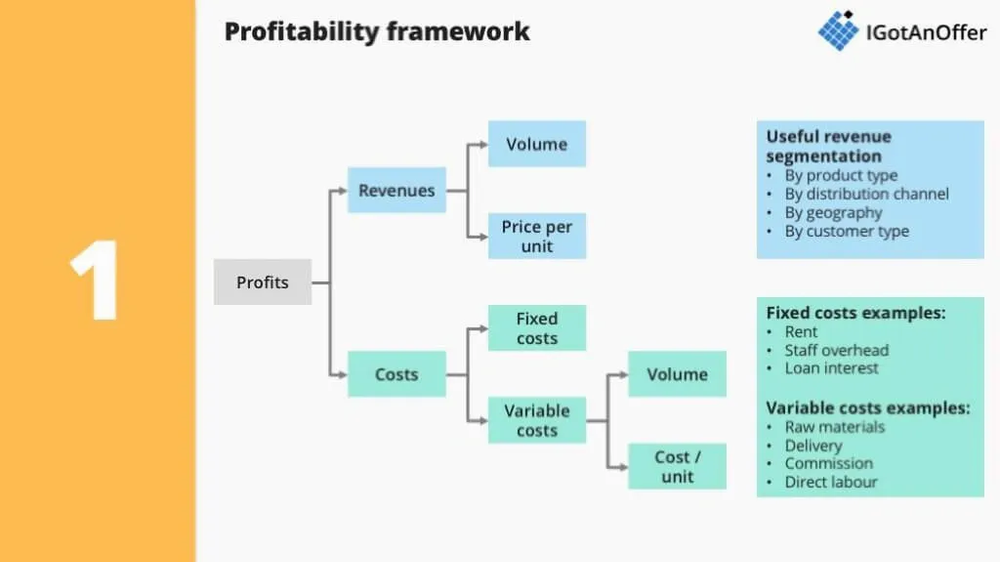
Check out this Profitability Framework from IGotAnOffer, an interview prep academy for aspiring consultants.
We use a similar framework for our Revenue and Marketing audits – the idea is the same, break it down to solve it.
When wanting to reduce your overall sales cycle, it’s easier to look at it from one next step to another.
For example, you’ve closed your first meeting with a prospect and have a next step in 2 weeks with a colleague. Your company is still not in the proposal stage thus you can anticipate another next step 3 weeks from there for a proposal.
In this fictional example, our sales cycle per step looks like this:
First step: 14 days.
Second step: 35 days.
FYI, you should always count the days from first meeting to the second step and from first meeting to the third step. It’s called sales cycle time for a reason (from start to finish). Oh, and weekends count, too!
How do you reduce the days between next steps you ask?
There is no silver bullet for this step; it requires complete collaboration between sales and marketing teams to close the distance.
Product marketing can create better messaging or better position their solutions to targets
OR
Content marketers can produce different types of content to activate and engage prospects
OR
Sales might need to revamp their sales skill with sales training. Often enough, the average salesperson does not ask for the next step at the end of a meeting (fail!).
What you gain from this metric
- Improved alignment between marketing and sales teams
- Ability to improve the First Meeting: Lead Ratio
- Ability to improve the Contract Win-Rate Ratio (more below)
Contract Win-Rate (%)
Final metric is the win-rate; the most popular metric of all and the favorite. Who doesn’t love a good close.
When marketing has visibility on the Win-Rate, it further improves alignment with Sales.
Sure, you might argue that once the lead is in the sales’ hands it’s up to them – and for the most part that is true, a lot of success in closing depends on sales.
But…
Once we’re all aligned towards a common goal, we can better pull resources to achieve mutually-agreed objectives.
For more on how to align sales and marketing, check out my insights piece on the Mentor Works column.
The 4-Step Framework for Crafting The Best Product Marketing Strategy
You finally made it!
If you’ve read this far, it will be well worth it!
The key to any successful product marketing strategy is to promote differentiation. Correct?
It’s about how to make your value proposition so unique that it will make competitors race towards beating you to the punch. Correct?
It would not be surprising if both your answers were “yes”. Would you be surprised if I told you that it’s not entirely correct?
Studies consistently show that product differentiation will not dramatically improve the performance of your product marketing strategy.
Why?
Because a good marketing strategy is really all about process.
Here is a 4 step framework (process) to create an incredibly strong value proposition and differentiation strategy.
Introducing the ERRC Blue Ocean Framework
The Eliminate, Reduce, Raise and Create framework was made famous by Chan Kim and Renee Mauborgne in their book Blue Ocean Strategy.
To make an amazing book short, the idea is to tap into potential demand in the market place by tapping into uncontested markets. To achieve this, a product marketing strategy must not put emphasis on differentiation, but on value innovation; the simultaneous pursuit of value at a low cost.
For example, Cirque du Soleil reinvented the circus industry by taking attributes from the entertainment and arts world and packaging it into a circus event.
The idea with EERC framework is to hone in on what really matters to customers and in turn craft a compelling message for different types of stakeholders.
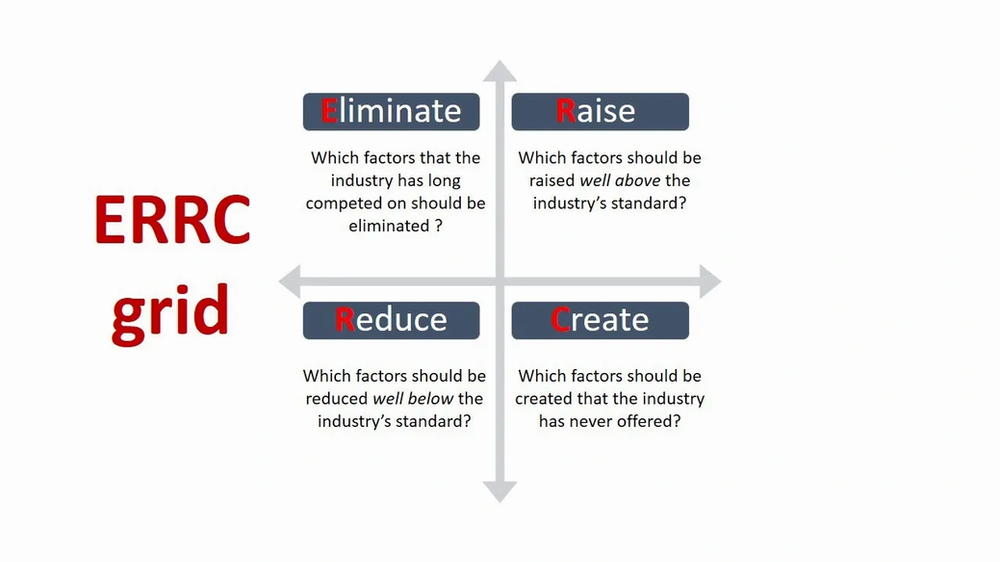
Blue Ocean Strategy: EERC Grid
Notice the EERC grid above.
Whether you’re currently in Go to Market phase, launching a new product line or simply repositioning a product, the idea is always to ask the following:
- Which factors that the industry has long competed on should be eliminated?
- Which factors should be reduced well below the industry’s standard?
- Which factors should be raised well above the industry’s standard?
- Which factors should be created that the industry has never offered?
While you might dread the thought of going through these questions, it is a useful exercise to promote differentiation and value at a low cost.
To make answering these questions easy, it’s best to map out graphically what the competition is competing on using a strategy canvas.
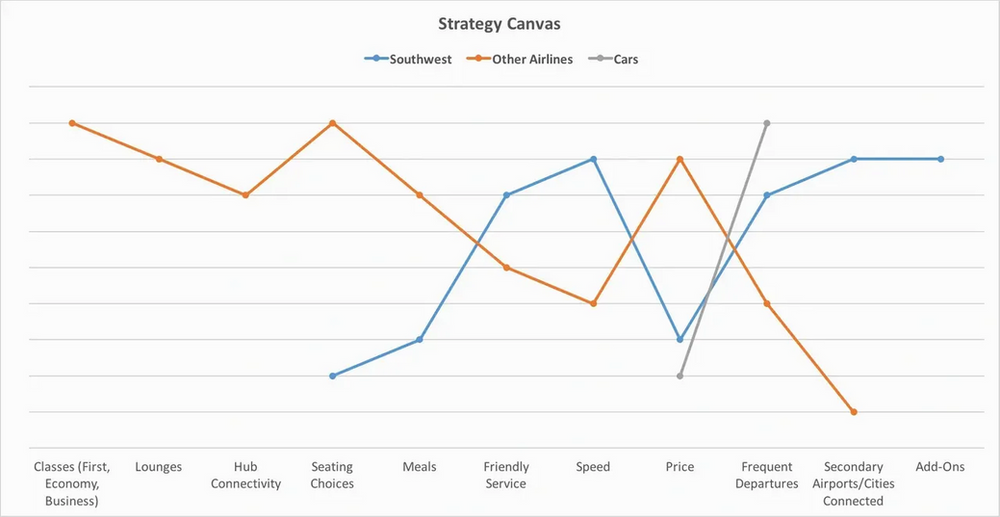
Look at the Southwest airlines strategy canvas below.
When compared to the traditional airlines, Southwest was able to differentiate by:
Eliminating:
- Classes
- Lounges
- Hub Connectivity
Reducing:
- Seating Choice
- Meals
- Price
Raising:
- Speed
- Service
- Frequent Departures
- Secondary Airports
Creating (differentiation)
- Add-Ons
The idea with EERC is to diverge from competitors and focus on something different that customers value. In this case, creating add-ons was something new and unique at the time which enabled the airlines’ customers to feel the convenience of traveling in a car but at the speed of a plan.
All this preceded Southwest’s legendary tagline:
The speed of a plane at the price of a car – whenever you need it.
Isn’t that a legendary product marketing strategy?
Now, implementing this in B2B means one extra layer of complexity…
You guessed it…
You have to adapt the tagline to the different stakeholder functions at target audiences. What this means is that your tagline for IT stakeholders will be dramatically different than for Marketing stakeholders.
Conclusion
We’re living in weird times, therefore we must think weirdly, too.
Product marketers have a much larger role to play in the B2B buying process given that sales and marketing have to be aligned in a fast pace environment.
Product marketing needs not only to position products and craft compelling messaging, but they need to work with sales and content teams to raise awareness and create engagement with prospects.
Furthermore, to win in B2B, sales and marketing must be aligned.
To align sales and marketing, measure:
- First Meeting : Lead Ratio
- AVG Days per Sale Cycle
- AVG Days per Next Step
- Win-Rates
Finally, to simplify the product marketing process and align sales and marketing, it’s a useful exercise for content marketing, sales and product marketing teams to go back to the drawing board and look at their strategy canvas, implement EERC, and craft compelling messaging for different target stakeholders.

